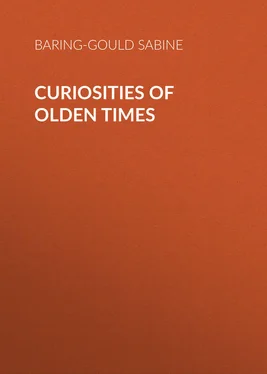Sabine Baring-Gould - Curiosities of Olden Times
Здесь есть возможность читать онлайн «Sabine Baring-Gould - Curiosities of Olden Times» — ознакомительный отрывок электронной книги совершенно бесплатно, а после прочтения отрывка купить полную версию. В некоторых случаях можно слушать аудио, скачать через торрент в формате fb2 и присутствует краткое содержание. ISBN: , Жанр: foreign_antique, foreign_prose, на английском языке. Описание произведения, (предисловие) а так же отзывы посетителей доступны на портале библиотеки ЛибКат.
- Название:Curiosities of Olden Times
- Автор:
- Жанр:
- Год:неизвестен
- ISBN:http://www.gutenberg.org/ebooks/41546
- Рейтинг книги:3 / 5. Голосов: 1
-
Избранное:Добавить в избранное
- Отзывы:
-
Ваша оценка:
- 60
- 1
- 2
- 3
- 4
- 5
Curiosities of Olden Times: краткое содержание, описание и аннотация
Предлагаем к чтению аннотацию, описание, краткое содержание или предисловие (зависит от того, что написал сам автор книги «Curiosities of Olden Times»). Если вы не нашли необходимую информацию о книге — напишите в комментариях, мы постараемся отыскать её.
Curiosities of Olden Times — читать онлайн ознакомительный отрывок
Ниже представлен текст книги, разбитый по страницам. Система сохранения места последней прочитанной страницы, позволяет с удобством читать онлайн бесплатно книгу «Curiosities of Olden Times», без необходимости каждый раз заново искать на чём Вы остановились. Поставьте закладку, и сможете в любой момент перейти на страницу, на которой закончили чтение.
Интервал:
Закладка:
S. Baring-Gould
Curiosities of Olden Times
An antiquary lights on many a curiosity whilst overhauling the dusty tomes of ancient writers. This little book is a small museum in which I have preserved some of the quaintest relics which have attracted my notice during my labours. The majority of the articles were published in 1869. I have now added some others.
Lew Trenchard,
September 1895 .
THE MEANING OF MOURNING
A strip of black cloth an inch and a half in width stitched round the sleeve – that is the final, or perhaps penultimate expression (for it may dwindle further to a black thread) of the usage of wearing mourning on the decease of a relative.
The usage is one that commends itself to us as an outward and visible sign of the inward sentiment of bereavement, and not one in ten thousand who adopt mourning has any idea that it ever possessed a signification of another sort. And yet the correlations of general custom – of mourning fashions, lead us to the inexorable conclusion that in its inception the practice had quite a different signification from that now attributed to it, nay more, that it is solely because its primitive meaning has been absolutely forgotten, and an entirely novel significance given to it, that mourning is still employed after a death.
Look back through the telescope of anthropology at our primitive ancestors in their naked savagery, and we see them daub themselves with soot mingled with tallow. When the savage assumed clothes and became a civilised man, he replaced the fat and lampblack with black cloth, and this black cloth has descended to us in the nineteenth century as the customary and intelligible trappings of woe.
The Chinaman when in a condition of bereavement assumes white garments, and we may be pretty certain that his barbarous ancestor, like the Andaman Islander of the present day, pipeclayed his naked body after the decease and funeral of a relative. In Egypt yellow was the symbol of sorrow for a death, and that points back to the ancestral nude Egyptian having smeared himself with yellow ochre.
Black was not the universal hue of mourning in Europe. In Castile white obtained on the death of its princes. Herrera states that the last time white was thus employed was in 1498, on the death of Prince John. This use of white in Castile indicates chalk or pipeclay as the daub affected by the ancestors of the house of Castile in primeval time as a badge of bereavement.
Various explanations have been offered to account for the variance of colour. White has been supposed to denote purity; and to this day white gloves and hat-bands and scarves are employed at the funeral of a young girl, as in the old ballad of “The Bride’s Burial”: —
A garland fresh and fair
Of lilies there was made,
In signs of her virginity,
And on her coffin laid.
Six pretty maidens, all in white ,
Did bear her to the ground,
The bells did ring in solemn swing
And made a doleful sound.
Yellow has been supposed to symbolise that death is the end of human hopes, because falling leaves are sere; black is taken as the privation of light; and purple or violet also affected as a blending of joy with sorrow. Christian moralists have declaimed against black as heathen, as denoting an aspect of death devoid of hope, and gradually purple is taking its place in the trappings of the hearse, if not of the mourners, and the pall is now very generally violet.
But these explanations are afterthoughts, and an attempt to give reason for the divergence of usage which might satisfy, but these are really no explanations at all. The usage goes back to a period when there were no such refinements of thought. If violet or purple has been traditional, it is so merely because the ancestral Briton stained himself with woad on the death of a relative.
The pipeclay, lampblack, yellow ochre, and woad of the primeval mourners must be brought into range with a whole series of other mourning usages, and then the result is something of an “eye-opener.” It reveals a condition of mind and an aspect of death that causes not a little surprise and amusement. It is one of the most astonishing, and, perhaps, shocking traits of barbarous life, that death revolutionises completely the feelings of the survivors towards their deceased husbands, wives, parents, and other relatives.
A married couple may have been sincerely attached to each other so long as the vital spark was twinkling, but the moment it is extinguished the dead partner becomes, not a sadly sweet reminiscence, but an object of the liveliest terror to the survivor. He or she does everything that ingenuity can suggest to get him or herself out of all association in body and spirit with the late lamented. Death is held to be thoroughly demoralising to the deceased. However exemplary a person he or she may have been in life, after death the ghost is little less than a plaguing, spiteful spirit.
There is in the savage no tender clinging to the remembrance of the loved one, he is translated into a terrible bugbear, who must be evaded and avoided by every contrivance conceivable. This is due, doubtless, mainly to the inability of the uncultivated mind to discriminate between what is seen waking from what presents itself in phantasy to the dreaming head. After a funeral, it is natural enough for the mourners to dream of the dead, and they at once conclude that they have been visited by his revenant . After a funeral feast, a great gorging of pork or beef, it is very natural that the sense of oppression and pain felt should be associated with the dear departed, and should translate itself into the idea that he has come from his grave to sit on the chests of those who have bewailed him.
Moreover, the savage associates the idea of desolation, death, discomfort, with the condition of the soul after death, and believes that the ghosts do all they can to return to their former haunts and associates for the sake of the warmth and food, the shelter of the huts, and the entertainment of the society of their fellows. But the living men and women are not at all eager to receive the ghosts into the family circle, and they accordingly adopt all kinds of “dodges,” expedients to prevent the departed from making these irksome and undesired visits.
The Venerable Bede tells us that Laurence, Archbishop of Canterbury, resolved on flying from England because he was hopeless of effecting any good under the successor of Ethelbert, king of Kent. The night before he fled he slept on the floor of the church, and dreamed that St. Peter cudgelled him soundly for resolving to abandon his sacred charge. In the morning he awoke stiff and full of aches and pains. Turned into modern language, we should say that Archbishop Laurence was attacked with rheumatism on account of his having slept on the cold stones of the church. His mind had been troubled before he went to sleep with doubts whether he were doing right in abandoning his duty, and very naturally this trouble of conscience coloured his dream, and gave to his rheumatic twinges the complexion it assumed.
Now Archbishop Laurence regarded the Prince of the Apostles in precisely the light in which a savage views his deceased relatives and ancestors. He associates his maladies, his pains, with theirs, if he should happen to dream of them. If, however, when in pain, he dreams of a living person, then he holds that this living person has cast a magical spell over him.
Among nature’s men, before they have gone through the mill of civilisation, plenty to eat and to drink, and some one to talk to, are the essentials of happiness. They see that the dead have none of these requisites, they consider that they are miserable without them. The writer remembers how, when he was a boy, and attended a funeral of a relative in November, he could not sleep all night – a bitter, frosty night – with the thought how cold it must be to the dead in the vault, without blankets, hot bottle, or fire. It was in vain for him to reason against the feeling; the feeling was so strong on him that he was conscious of an uncomfortable expectation of the dead coming to claim a share of the blanket, fire, or hot bottle. Now the savage never reasons against such a feeling, and he assumes that the dead will return, as a matter of course, for what he cannot have in the grave.
Читать дальшеИнтервал:
Закладка:
Похожие книги на «Curiosities of Olden Times»
Представляем Вашему вниманию похожие книги на «Curiosities of Olden Times» списком для выбора. Мы отобрали схожую по названию и смыслу литературу в надежде предоставить читателям больше вариантов отыскать новые, интересные, ещё непрочитанные произведения.
Обсуждение, отзывы о книге «Curiosities of Olden Times» и просто собственные мнения читателей. Оставьте ваши комментарии, напишите, что Вы думаете о произведении, его смысле или главных героях. Укажите что конкретно понравилось, а что нет, и почему Вы так считаете.












